Temperature Mercury Mystique 1999 Owner's Manuals
[x] Cancel search | Manufacturer: MERCURY, Model Year: 1999, Model line: Mystique, Model: Mercury Mystique 1999Pages: 244, PDF Size: 2.15 MB
Page 12 of 244
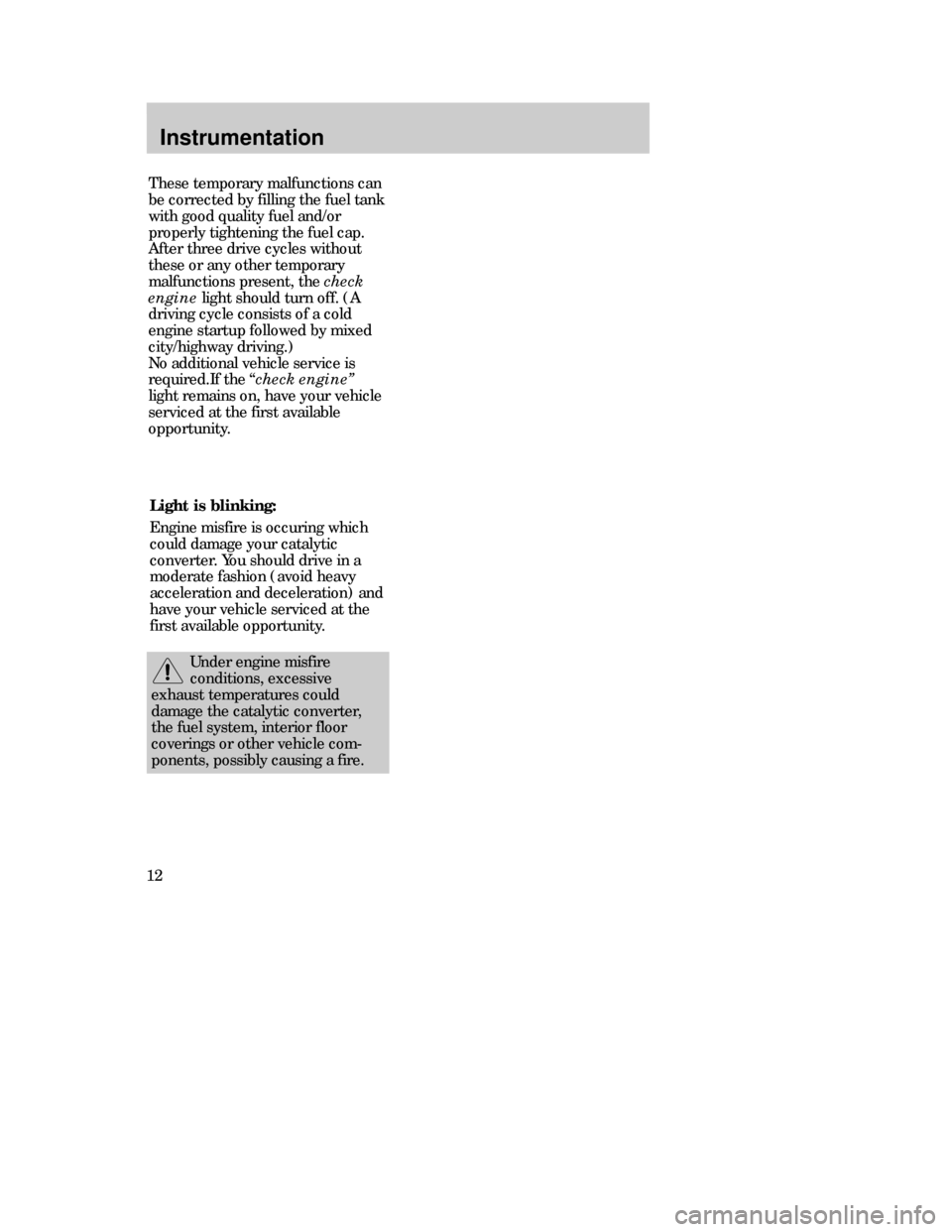
Instrumentation
12These temporary malfunctions can
be corrected by filling the fuel tank
with good quality fuel and/or
properly tightening the fuel cap.
After three drive cycles without
these or any other temporary
malfunctions present, the
check
engine
light should turn off. (A
driving cycle consists of a cold
engine startup followed by mixed
city/highway driving.)
No additional vehicle service is
required.If the Ò
check engineÓ
light remains on, have your vehicle
serviced at the first available
opportunity.
Light is blinking:
Engine misfire is occuring which
could damage your catalytic
converter. You should drive in a
moderate fashion (avoid heavy
acceleration and deceleration) and
have your vehicle serviced at the
first available opportunity.
Under engine misfire
conditions, excessive
exhaust temperatures could
damage the catalytic converter,
the fuel system, interior floor
coverings or other vehicle com-
ponents, possibly causing a fire.
12MInen 4/13/99 2:11 PM Page 12
Page 18 of 244

Instrumentation
18
CH
Engine coolant temperature
gauge
Indicates the temperature of the
engine coolant. If it enters the red
section, the engine is overheating.
Switch off the ignition and
determine the source of the
problem. Refer to
Checking and
adding engine coolant
in the
Maintenance and care chapter.
EF
BRAKE
TRACTION
CONTROLO/D
OFF
000123
000010 20 3040506070
80
90
110
120
13 0
MPH
20 4060
55
80120 10 0
14 0
160
18 0
20010 0
CHECK
ENGINETRACTION
CONTROL
CH
000123
000010 20 3040506070
80
90
110
120
13 0
MPH
20 4060
55
80120 10 0
14 0
160
18 0
20010 0
EF12
03
x 1000
4
5
6
7
8
O/D
OFFCHECK
ENGINE
BRAKE
TRACTION
CONTROL
CH
INSTRUMENT CLUSTER
GAUGES
12MInen 4/13/99 2:11 PM Page 18
Page 25 of 244

Controls and features
25
Heater only system
(if equipped)OFF LO PNL/FLR
PANEL FLOOR
DEF FLR
DEF
HI/
LO
HI
Temperature control knob
Controls the temperature of the
airflow inside the vehicle. On
heater-only systems, the air cannot
be cooled below the outside
temperature.
Mode selector control
Controls the direction of the
airflow to the inside of the vehicle.
¥ PANEL Ð Distributes outside air
through the instrument panel
registers.
¥ OFF Ð Outside air is shut out and
the fan will not operate.
¥ PNL/FLR Ð Distributes outside
air through the instrument panel
registers and the floor ducts.
¥ FLOOR Ð Allows for maximum
heating. Distributes outside air
through floor ducts.
Fan speed control
Controls the volume of air
circulated in the vehicle.
13MCten 4/13/99 3:35 PM Page 25
Page 27 of 244

Controls and features
27
Manual heating and air
conditioning system
(if equipped)OFF LO PNL/FLR
PANEL
A/CFLOOR
DEF FLR
DEF
MAX
A/C HI/
LO
HIFan speed control
Controls the volume of air
circulated in the vehicle.
Temperature control knob
Controls the temperature of the
airflow inside the vehicle.
OFF PNL/FLR
PANEL
A/CFLOOR
DEF FLR
DEF
MAX
A/C/Mode selector control
Controls the direction of the
airflow to the inside of the vehicle.
The air conditioning compressor
will operate in all modes except
PANEL, PNL/FLR, and FLOOR.
However, the air conditioning will
only function if the outside
temperature is about 10¡C (50¡F )
or above.
Since the air conditioner removes
considerable moisture from the air
during operation, it is normal if
clear water drips on the ground
under the air conditioner drain
while the system is working and
even after you have stopped the
vehicle.
13MCten 4/13/99 3:35 PM Page 27
Page 28 of 244
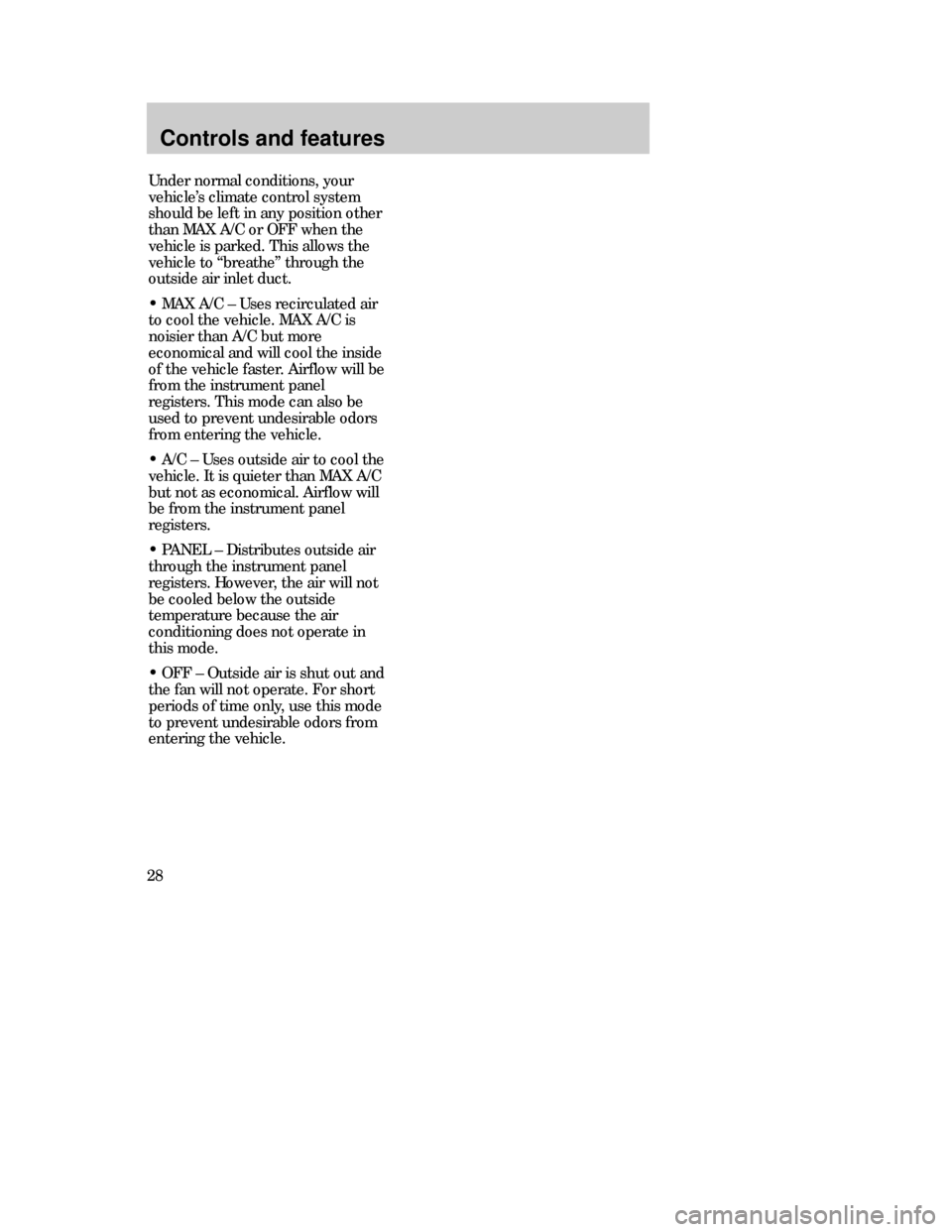
Controls and features
28
Under normal conditions, your
vehicleÕs climate control system
should be left in any position other
than MAX A/C or OFF when the
vehicle is parked. This allows the
vehicle to ÒbreatheÓ through the
outside air inlet duct.
¥ MAX A/C Ð Uses recirculated air
to cool the vehicle. MAX A/C is
noisier than A/C but more
economical and will cool the inside
of the vehicle faster. Airflow will be
from the instrument panel
registers. This mode can also be
used to prevent undesirable odors
from entering the vehicle.
¥ A/C Ð Uses outside air to cool the
vehicle. It is quieter than MAX A/C
but not as economical. Airflow will
be from the instrument panel
registers.
¥ PANEL Ð Distributes outside air
through the instrument panel
registers. However, the air will not
be cooled below the outside
temperature because the air
conditioning does not operate in
this mode.
¥ OFF Ð Outside air is shut out and
the fan will not operate. For short
periods of time only, use this mode
to prevent undesirable odors from
entering the vehicle.
13MCten 4/13/99 3:35 PM Page 28
Page 29 of 244

Controls and features
29
¥ PNL/FLR Ð Distributes outside
air through the instrument panel
registers and the floor ducts.
However, the air will not be cooled
below the outside temperature
because the air conditioning does
not operate in this mode. For
added customer comfort, when the
temperature control knob is
anywhere in between the full hot
and full cold positions, the air
distributed through the floor ducts
will be slightly warmer than the air
sent to the instrument panel
registers.
¥ FLOOR Ð Allows for maximum
heating by distributing outside air
through the floor ducts. However,
the air will not be cooled below the
outside temperature because the
air conditioning does not operate in
this mode.
¥ FLR/DEF Ð Distributes outside
air through the windshield
defroster ducts and the floor ducts.
Heating and air conditioning
capabilities are provided in this
mode. For added customer
comfort, the air distributed through
the floor ducts will be slightly
warmer than the air sent to the
windshield defroster ducts. If the
temperature is about 10¡C (50¡F)
or higher, the air conditioner will
automatically dehumidify the air to
prevent fogging.
13MCten 4/13/99 3:35 PM Page 29
Page 30 of 244
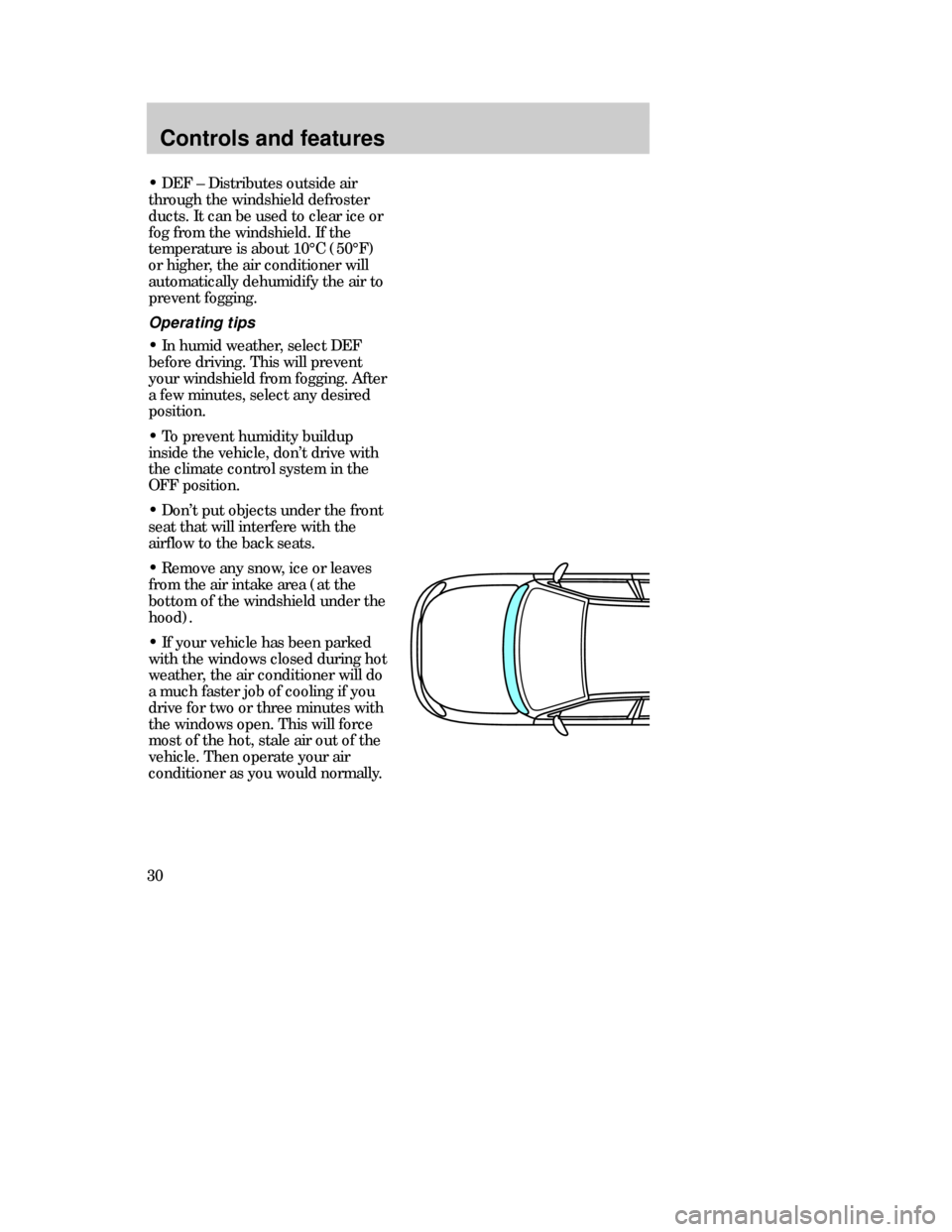
Controls and features
30
¥ DEF Ð Distributes outside air
through the windshield defroster
ducts. It can be used to clear ice or
fog from the windshield. If the
temperature is about 10¡C (50¡F)
or higher, the air conditioner will
automatically dehumidify the air to
prevent fogging.
Operating tips
¥ In humid weather, select DEF
before driving. This will prevent
your windshield from fogging. After
a few minutes, select any desired
position.
¥ To prevent humidity buildup
inside the vehicle, donÕt drive with
the climate control system in the
OFF position.
¥ DonÕt put objects under the front
seat that will interfere with the
airflow to the back seats.
¥ Remove any snow, ice or leaves
from the air intake area (at the
bottom of the windshield under the
hood).
¥ If your vehicle has been parked
with the windows closed during hot
weather, the air conditioner will do
a much faster job of cooling if you
drive for two or three minutes with
the windows open. This will force
most of the hot, stale air out of the
vehicle. Then operate your air
conditioner as you would normally.
13MCten 4/13/99 3:35 PM Page 30
Page 47 of 244
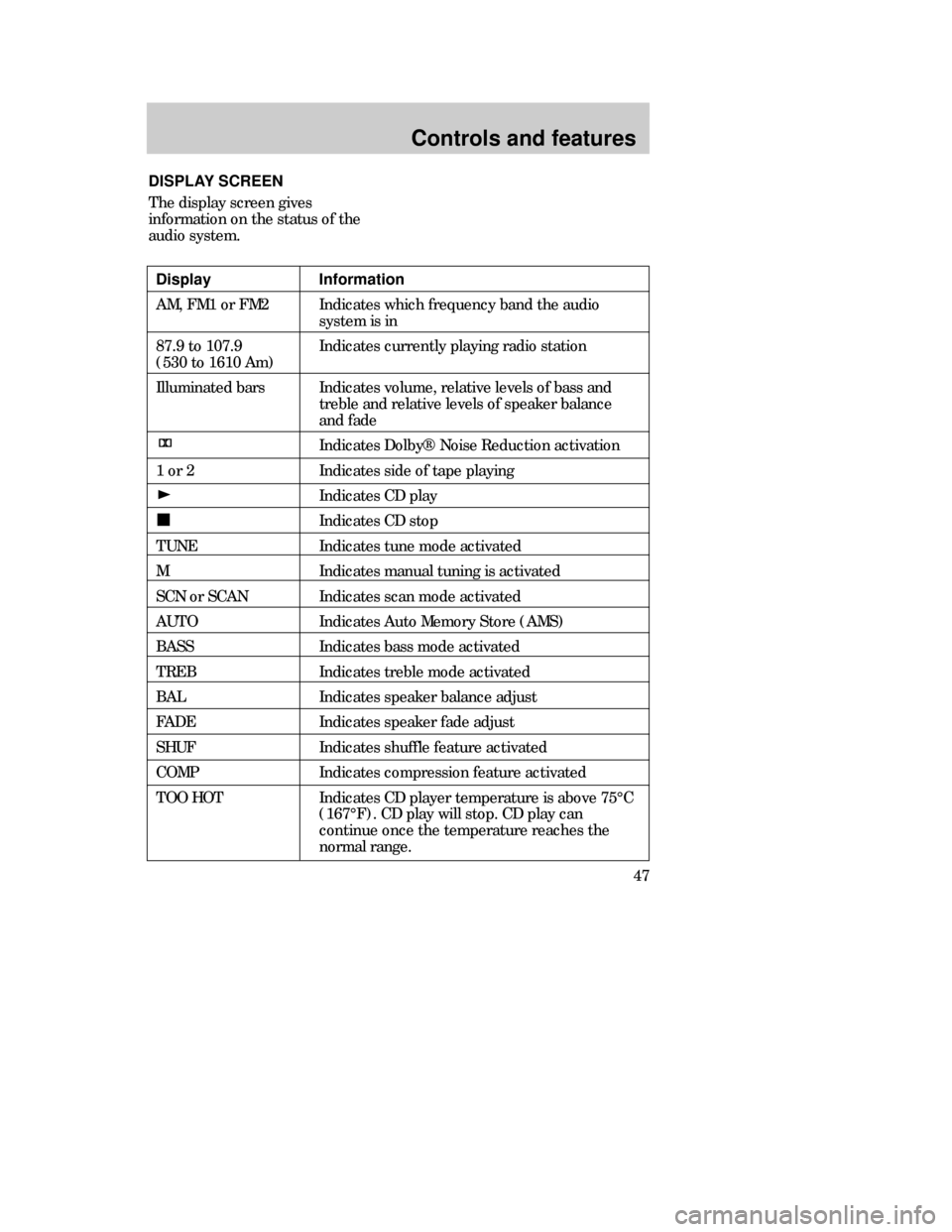
Controls and features
47
DISPLAY SCREEN
The display screen gives
information on the status of the
audio system.
Display Information
AM, FM1 or FM2 Indicates which frequency band the audio
system is in
87.9 to 107.9 Indicates currently playing radio station
(530 to 1610 Am)
Illuminated bars Indicates volume, relative levels of bass and
treble and relative levels of speaker balance
and fade
Indicates Dolby¨ Noise Reduction activation
1 or 2 Indicates side of tape playing
Indicates CD play
Indicates CD stop
TUNE Indicates tune mode activated
M Indicates manual tuning is activated
SCN or SCAN Indicates scan mode activated
AUTO Indicates Auto Memory Store (AMS)
BASS Indicates bass mode activated
TREB Indicates treble mode activated
BAL Indicates speaker balance adjust
FADE Indicates speaker fade adjust
SHUF Indicates shuffle feature activated
COMP Indicates compression feature activated
TOO HOT Indicates CD player temperature is above 75¡C
(167¡F). CD play will stop. CD play can
continue once the temperature reaches the
normal range.
13MCten 4/13/99 3:36 PM Page 47
Page 48 of 244
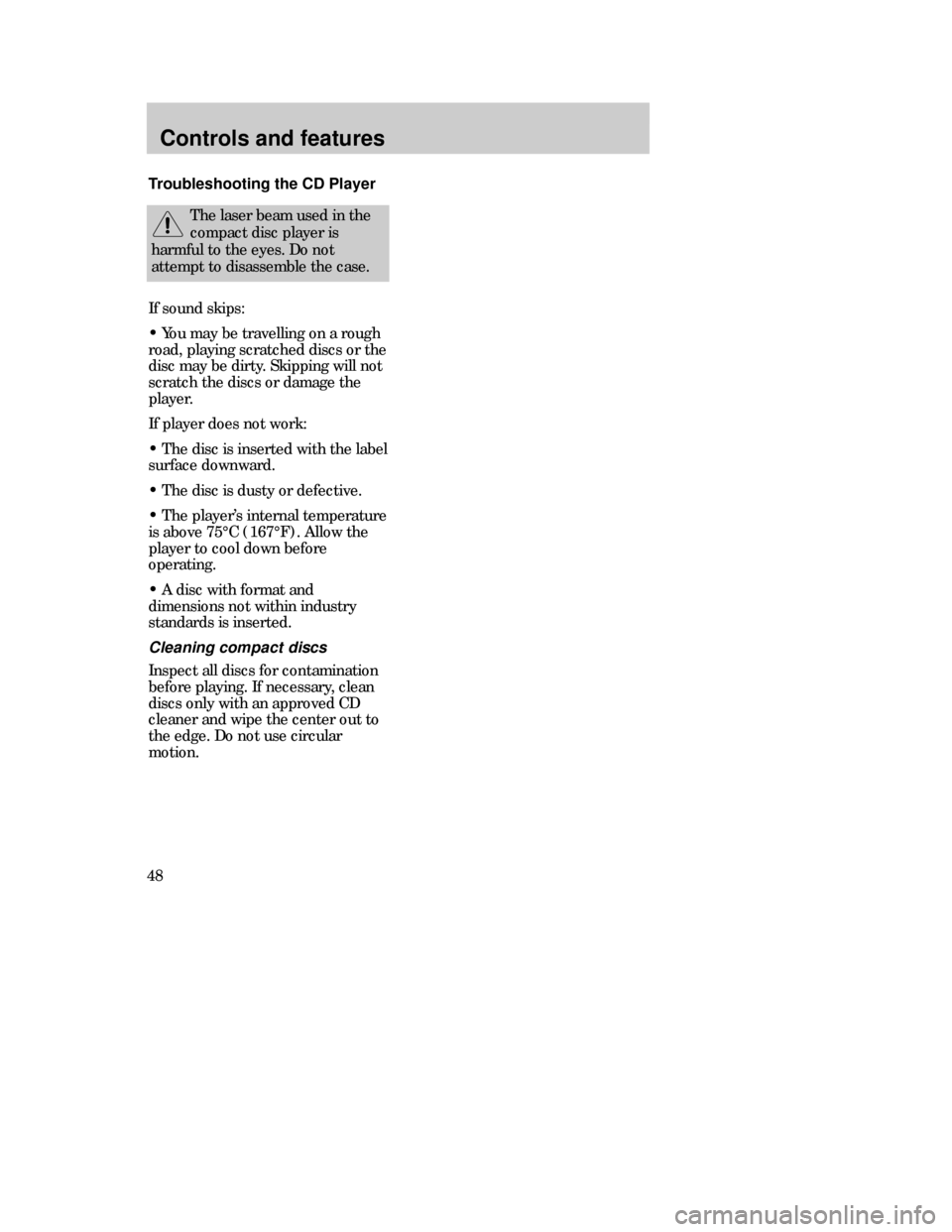
Controls and features
48
Troubleshooting the CD Player
The laser beam used in the
compact disc player is
harmful to the eyes. Do not
attempt to disassemble the case.
If sound skips:
¥ You may be travelling on a rough
road, playing scratched discs or the
disc may be dirty. Skipping will not
scratch the discs or damage the
player.
If player does not work:
¥ The disc is inserted with the label
surface downward.
¥ The disc is dusty or defective.
¥ The playerÕs internal temperature
is above 75¡C (167¡F). Allow the
player to cool down before
operating.
¥ A disc with format and
dimensions not within industry
standards is inserted.
Cleaning compact discs
Inspect all discs for contamination
before playing. If necessary, clean
discs only with an approved CD
cleaner and wipe the center out to
the edge. Do not use circular
motion.
13MCten 4/13/99 3:36 PM Page 48
Page 49 of 244
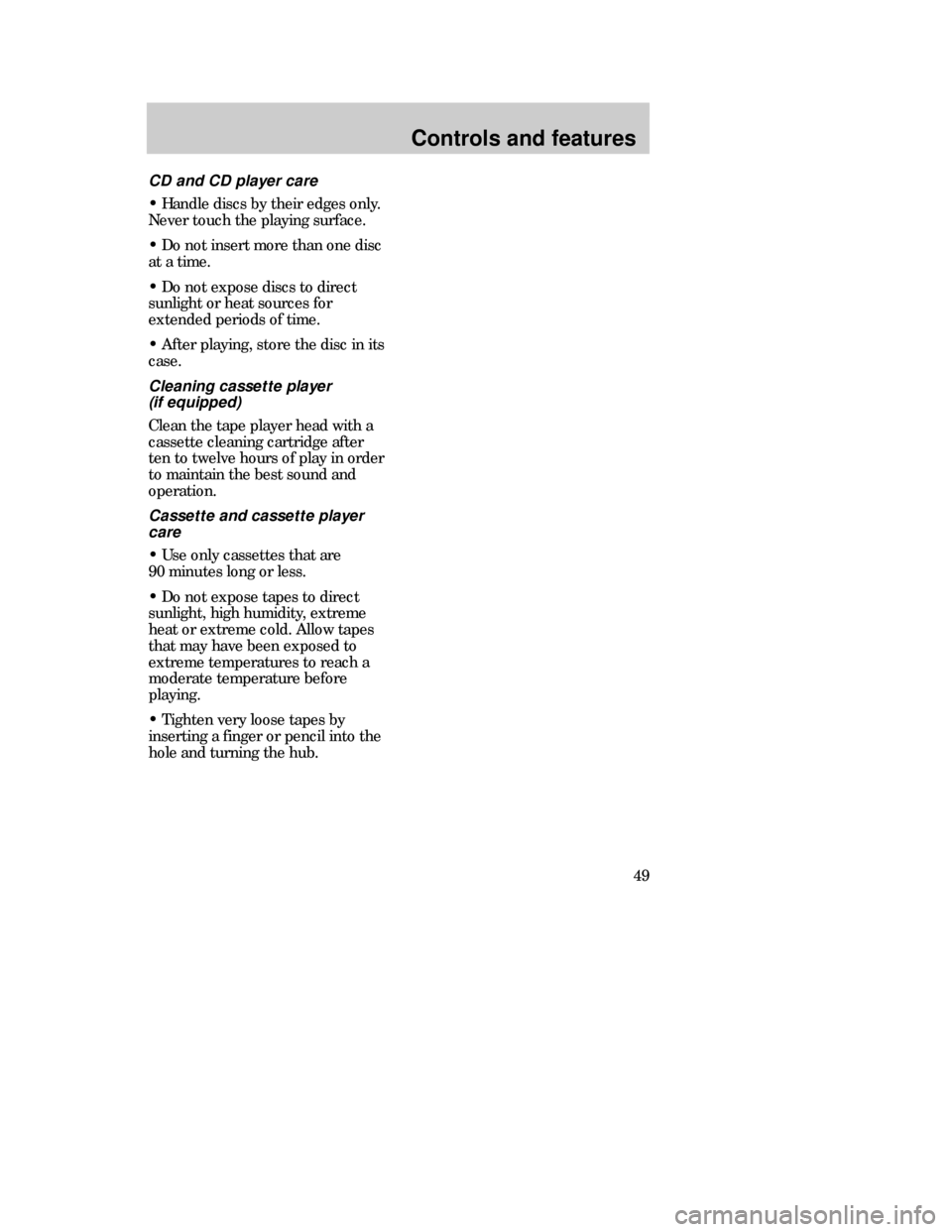
Controls and features
49
CD and CD player care
¥ Handle discs by their edges only.
Never touch the playing surface.
¥ Do not insert more than one disc
at a time.
¥ Do not expose discs to direct
sunlight or heat sources for
extended periods of time.
¥ After playing, store the disc in its
case.
Cleaning cassette player
(if equipped)
Clean the tape player head with a
cassette cleaning cartridge after
ten to twelve hours of play in order
to maintain the best sound and
operation.
Cassette and cassette player
care
¥ Use only cassettes that are
90 minutes long or less.
¥ Do not expose tapes to direct
sunlight, high humidity, extreme
heat or extreme cold. Allow tapes
that may have been exposed to
extreme temperatures to reach a
moderate temperature before
playing.
¥ Tighten very loose tapes by
inserting a finger or pencil into the
hole and turning the hub.
13MCten 4/13/99 3:36 PM Page 49